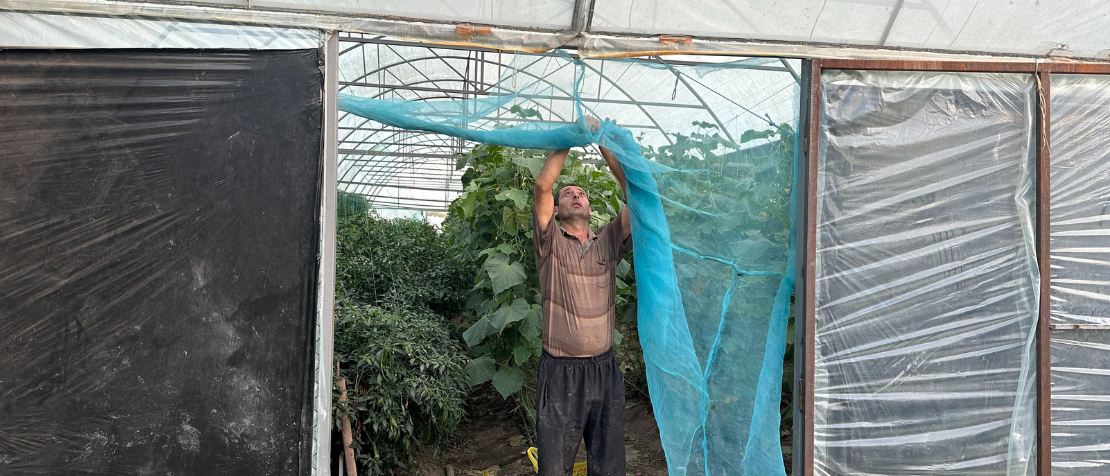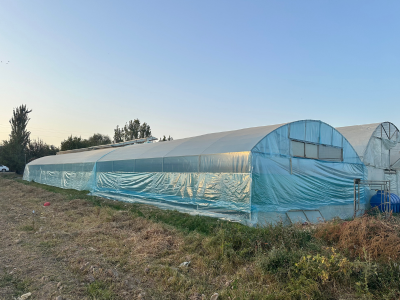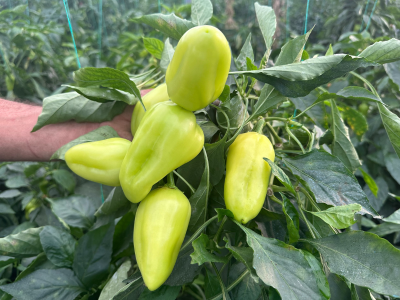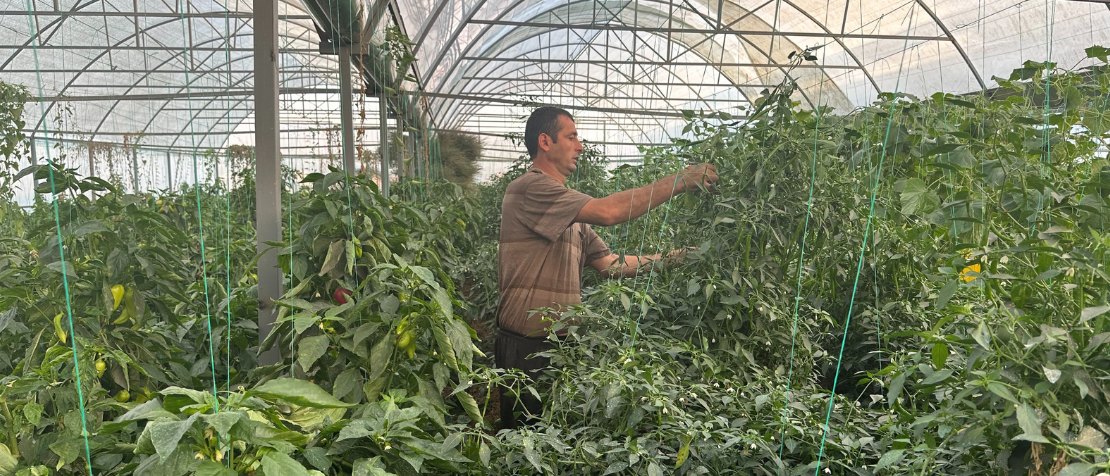
Innovative farming in Tajikistan
A family farmer's shift to sustainable greenhouse vegetable production
Safarmad Gadoev adjusts protective netting at the entrance of his greenhouse in Tajikistan, enhancing pest control measures to maintain a healthy crop environment.
©FAO/Munira Otambekova
03/04/2025
In the Khatlon region of Tajikistan, farming of cotton, wheat and other crops has long been the backbone of rural livelihoods. Safarmad Gadoev, a farmer from the city of Kulob, was one of many who relied on the production of these crops to support his family. But the challenges of cotton and wheat farming—rising production costs, fluctuating market prices, water scarcity, and the impacts of climate change—made it difficult for him to earn a stable income.
Despite being well-versed in traditional agriculture, having studied agronomy at the Kulob campus of the Technological University of Tajikistan, he found himself facing the same struggles as many smallholder farmers.
For decades, Tajikistan’s agricultural sector has been undergoing major changes, moving away from large-scale cotton production towards more diversified farming systems. Yet, many farmers lacked access to the necessary resources and training to effectively make this shift. Limited productivity, low market access, and food insecurity remained pressing concerns, with over 55 percent of both urban and rural family incomes being spent on food.
In response to these challenges, in 2020, the Food and Agriculture Organization of the United Nations (FAO), in collaboration with the Ministry of Agriculture of Tajikistan, launched a project which took advantage of Tajikistan’s favorable climatic conditions to develop sustainable, high-yield greenhouse vegetable production—a profitable enterprise that may help trigger economic growth in rural areas.


By growing off-season vegetables such as cucumbers, tomatoes, green peppers, and leafy greens, smallholder farmers also contribute to more diverse and nutritious diets. ©FAO/Munira Otambekova
Safarmad was among the farmers selected by the project to establish a demonstration site. For him, the transition to greenhouse farming was both an opportunity and a challenge.
“I knew how to grow cotton, wheat, and other crops in open fields, but this was completely new to me,” he recalls. “At first, I didn’t know how to manage a greenhouse or what it would take to make it work.”
FAO worked with Safarmad to install a 100 square metre, optimized greenhouse on his land. The “smart” greenhouse was equipped with insect nets, a ventilation system, a drip irrigation system, and a double-door entrance to prevent pest intrusion. These features ensured better temperature, humidity, nutrition, pest and disease control while reducing water use and reliance on chemical pesticides.
But infrastructure alone wasn’t enough—knowledge was key. FAO experts trained Safarmad and other pilot farmers from different regions of the country on best practices in greenhouse vegetable production, water and soil management, integrated pest management, food safety, and marketing strategies. The use of sticky insect traps, light traps, and organic-based pest control methods was introduced as a first step towards production of abundant and healthy yields.
Four years into his greenhouse journey, Safarmad has seen tangible results. His facility now produces 8 tonnes of cucumbers and 8 tonnes of tomatoes annually, generating significant income to sustain his family of four. These fresh vegetables are sold in local markets and even reach supermarkets in the capital city Dushanbe, where demand for high-quality, locally grown produce is increasing.
"Each season’s harvest brings a deep sense of satisfaction," Safarmad says. "We now have a steady income, and I no longer worry about unpredictable weather damaging my crops like before."
His total annual earnings have reached 120 000 Tajik Somoni (nearly USD 11 000), a significant increase compared to his previous income. With these profits, he has been able to expand his farming operations, investing in better seeds and fertilizers.
“This shift towards organic greenhouse farming is a direct result of FAO's efforts to reduce farmers' reliance on synthetic fertilizers and pesticides while meeting the growing market demand for chemical-free produce,” says Munira Otambekova, FAO project manager.
As climate change increases the risk of droughts, soil degradation, and unpredictable growing seasons, greenhouse farming is giving new hope and offering strategic solutions for the agrifood sector in Tajikistan.

Inside his greenhouse, Safarmad tends to cucumber plants, part of a climate-smart agriculture initiative to increase food production with efficient use of water and nutrients. ©FAO/Munira Otambekova
"Greenhouse vegetable production is one of the key technologies to mitigate climate change because the protected system allows us to produce more food with fewer inputs. Tajikistan has great potential for expanding climate-smart practices in agriculture, and we at FAO stand ready to provide technical support," says Aghasi Harutyunyan, FAO Representative a.i. in Tajikistan.
By growing off-season vegetables such as cucumbers, tomatoes, green peppers and leafy greens, farmers also contribute to a more diverse and nutritious diet for Tajikistan’s population, particularly for children and women who are most vulnerable to micronutrient deficiencies.
Beyond its economic and technical impact, the greenhouse has also become a family-centered enterprise for Safarmad. His 12-year-old son, Alikhon, now helps with daily tasks and earns pocket money from vegetable sales. “Seeing him learn and take pride in our work makes me think we’re on the right path,” Safarmad says with a smile.
His success has also ignited interest in his community as more and more neighbors are considering adopting greenhouse farming, inspired by how it has improved Safarmad’s living conditions.
FAO continues to work towards ensuring the sustainability of greenhouse farming and upscaling such practices in the country.
For Safarmad, what began as an uncertain venture has now become a thriving business. With the right support, training, and determination, traditional farming communities are embracing innovation and build a more resilient, food-secure future for Tajikistan.
Website: FAO country profile: Tajikistan
Publication: Strengthening the capacities of farmers and rural population on greenhouse vegetable production
